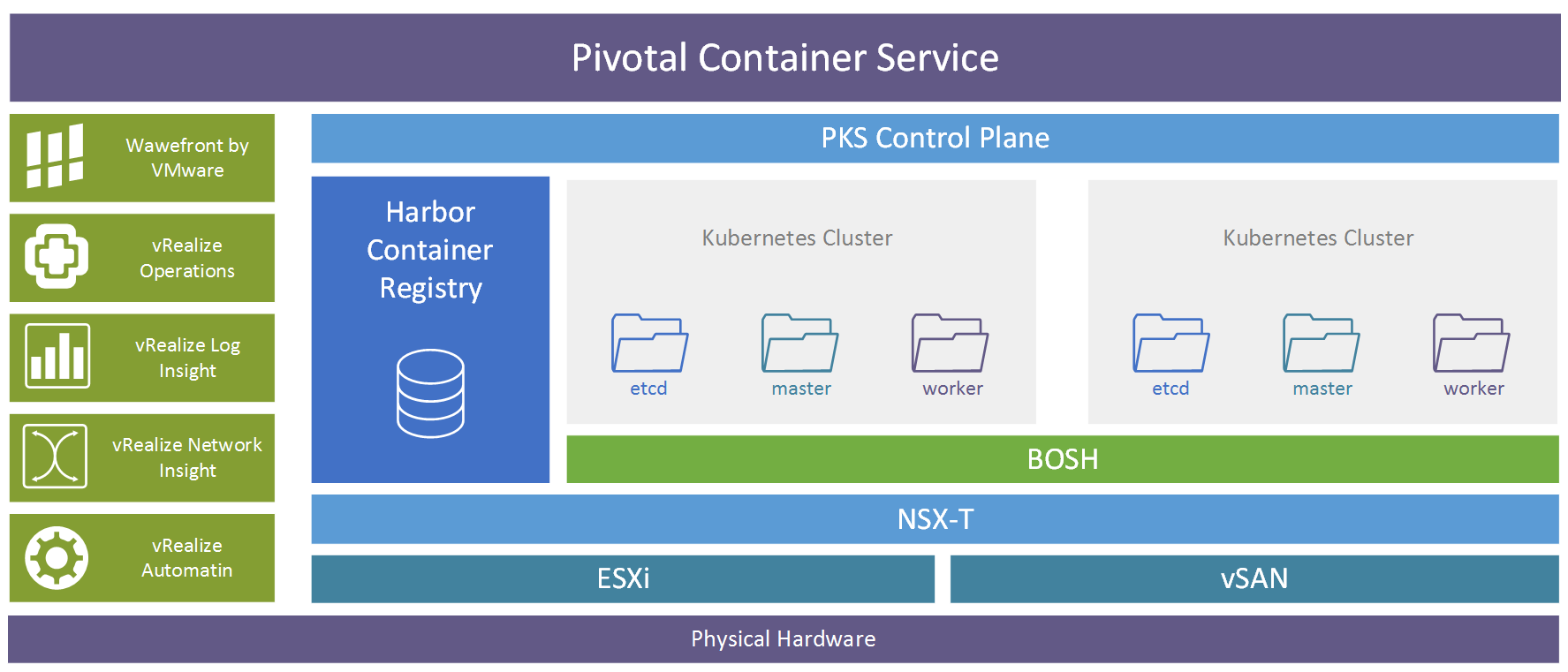With more than 500,000 customers globally, VMware remains a proven leader not only in virtualization but also in all technologies related to digital transformation. This year marks 20 years since the creation of VMware by Diane Greene, Mendel Rosenblum, Scott Devine, Ellen Wang, and Edouard Bugnion in 1998.
VMware has always focused on virtualization and its flagship product—VMware vSphere—proves that this was the right choice. The first version of ESXi hypervisor was released in 2001 and the first version of vCenter was then released two years later in 2003.
The VMware vSphere suite includes ESXi (the evolution of ESX Server) for the virtualization layer and the vCenter Server for the management layer.
Compute virtualization is only the first step here; to move to a real cloud computing infrastructure, you will not only need to compute resource abstraction (provided by virtualization) but also operation automation and agility (both of these are only partially obtainable through virtualization). Finally, this approach should not only be applied to the compute virtualization but also to the other resources, such as storage, networking, and security.
Today, VMware products can be used to fulfill this vision. There are three infrastructure pillars that VMware virtualizes:
- Compute resources—VMware vSphere
- Storage resources—VMware vSAN
- Network resources—VMware NSX
Together, these products build a unified platform for delivering any service with unmatched performance.
In this book, we are focusing primarily on VMware vSphere, but we will also touch on vSAN and NSX. However, this won't be covered in too much detail, as we will mainly look at compute virtualization using VMware vSphere.
"VMware is helping our customers and partners to achieve unlimited possibilities, while a shift to the digital is accelerating a technology supply to invent new products, deliver new services and find new ways to work and grow a business. Our solutions enable a business to build precisely what is needed in the way it is needed for today and tomorrow."
– Pat Gelsinger, VMware CEO
The digital transformation journey has four IT priorities that VMware focuses on:
- Modernizing data centers: Software-defined data center architecture to modernize existing data centers painlessly and automation to run enterprise and cloud-native workloads.
- Integrating public clouds: Provides extra agility and cross-cloud architecture. Cloud freedom brings a choice, and you can easily extend your on-premises infrastructure to include any vSphere-based-public cloud.
- Empowering the digital workspace: Introduces an exceptional mobile experience by providing users with a secure and digital workspace. VMware delivers virtualized applications and offers the ability to manage apps, access, and endpoints securely.
- Transforming security: This transformative approach to security delivers secure infrastructure, networks and applications, data, and access from end to end, securing on-premises data centers through a cloud connected to the endpoint and device.
“The Software-Defined datacenter is VMware technology architecture for building a data center where all infrastructure is virtualized, and control of the data center is fully automated with software.”
– June Yang, VMware Sr. Director for vSphere
Based on this strategy, there are three key pillars that VMware follows:
- Continuous innovation and integration of vSphere core components: A software-defined data center is more scalable, provides better performance, and is secure as well as easier to manage and operate.
- Unified hybrid cloud capabilities: Customers want the choice to run applications on both the private and public cloud. The idea here is to provide the agility and flexibility that is required by a business while enabling the right level of performance, continuity, and security that IT is responsible for delivering.
- Any application: vSphere is the best platform to run any application from traditional enterprise applications to cloud-native workloads. VMware is very successful when running traditional applications, and now the goal is to extend this to cloud-native workloads as well.
In 2012, former VMware CTO Steve Herrod explained this vision with the new concept of the SDDC, where all infrastructure elements (computing, networking, storage, and security) are virtualized and delivered as a service using a cloud computing model:
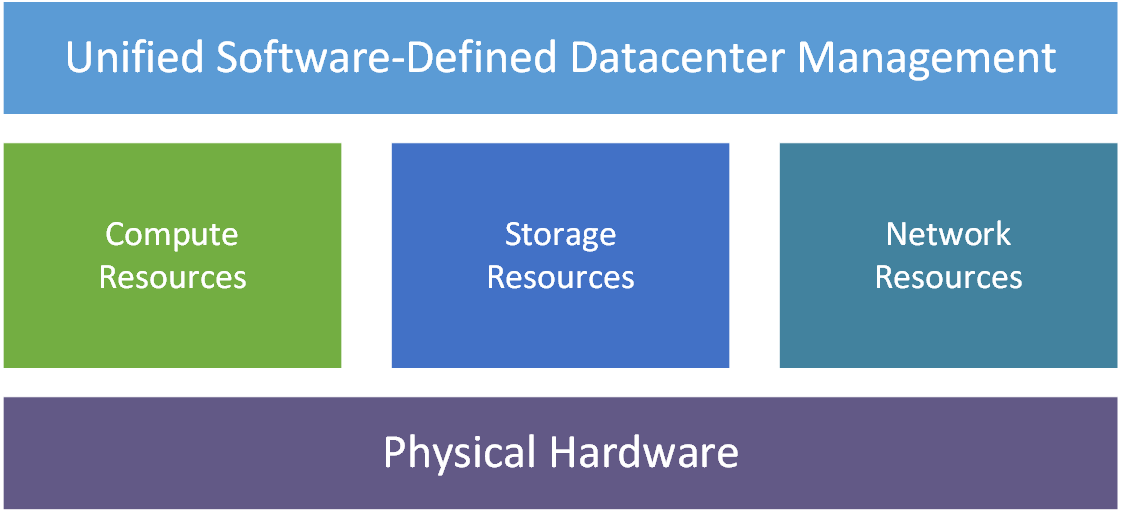
Virtualization is no longer the final destination of the digital transformation journey; it has become the starting point, an essential requirement, and a foundation for digital businesses. VMware has addressed these needs by extending both its product portfolio and its vision.
Together, VMware vSphere, NSX, and vSAN are unified building blocks which form an SDDC. As we will explain later, this approach incorporates nicely with hyper-converged infrastructure, a physical server that contains not only computer resources but also local storage devices for building software-defined storage. Hyper-converged servers are physical infrastructure blocks for SDDCs.
As an extension to this approach, the Cloud Foundation product can be leveraged. VMware Cloud Foundation is an integrated software platform that automates the deployment and life cycle management of a complete SDDC on a standardized hyper-converged architecture. This can be deployed on-premises on a broad range of supported hardware, or consumed as a service in the public cloud (VMware Cloud on AWS or VMware Cloud Providers).
The following represents a high-level overview of the VMware Cloud Foundation product:
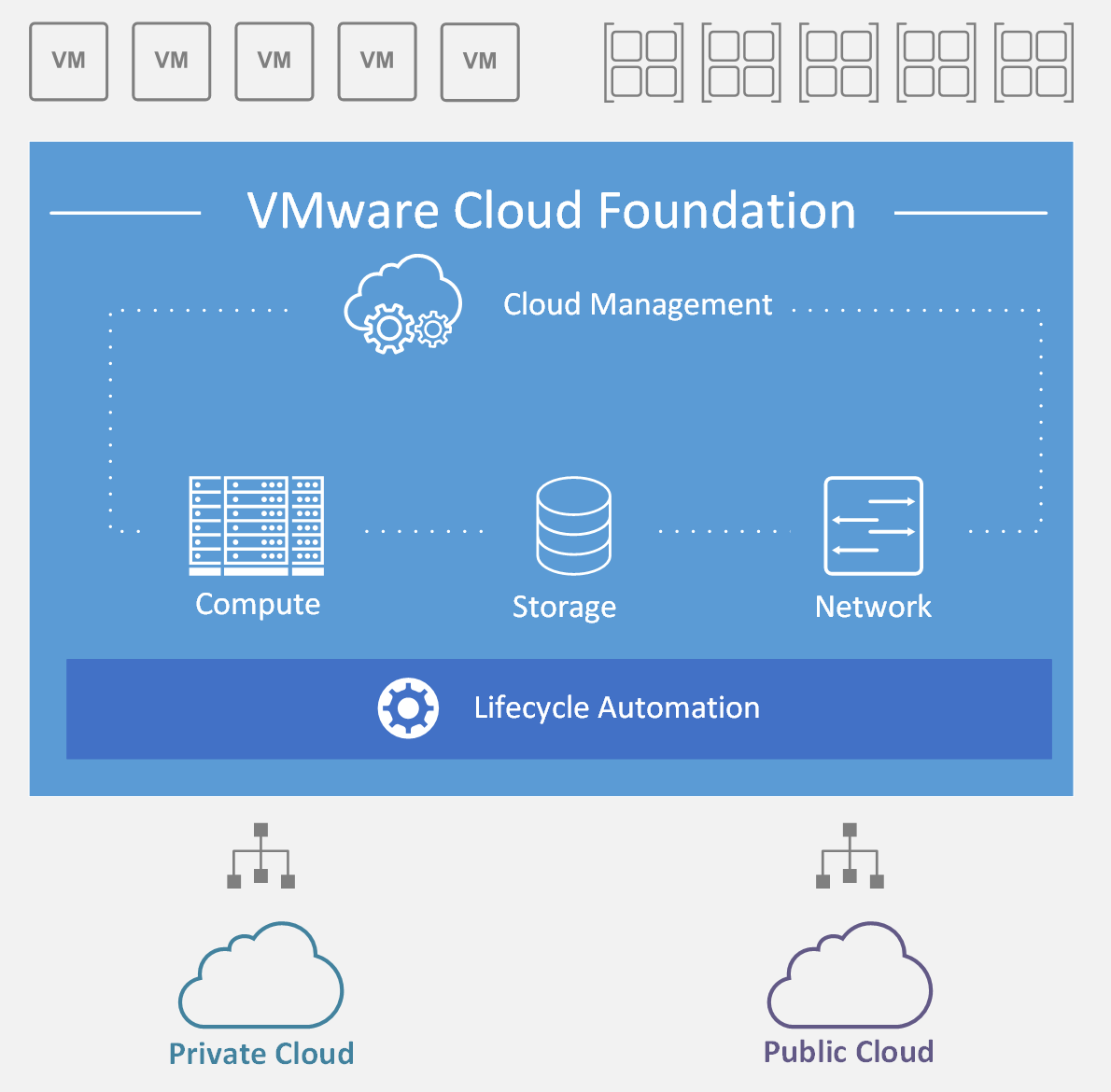
For more information about VMware Cloud Foundation, feel free to visit the official product brief at https://www.vmware.com/content/dam/digitalmarketing/vmware/en/pdf/datasheet/products/vmware-cloud-foundation-datasheet.pdf.
Containers and VMs have similar resource isolation and resource allocation benefits, but function differently, because containers do not include the operating system part (or at least not the kernel part of it). Containers are also more lightweight, so they are potentially more portable and efficient.
With containers you do not need an underlying operating system for each container but individual Containers are run on the shared Host Operating System through Docker Engine:
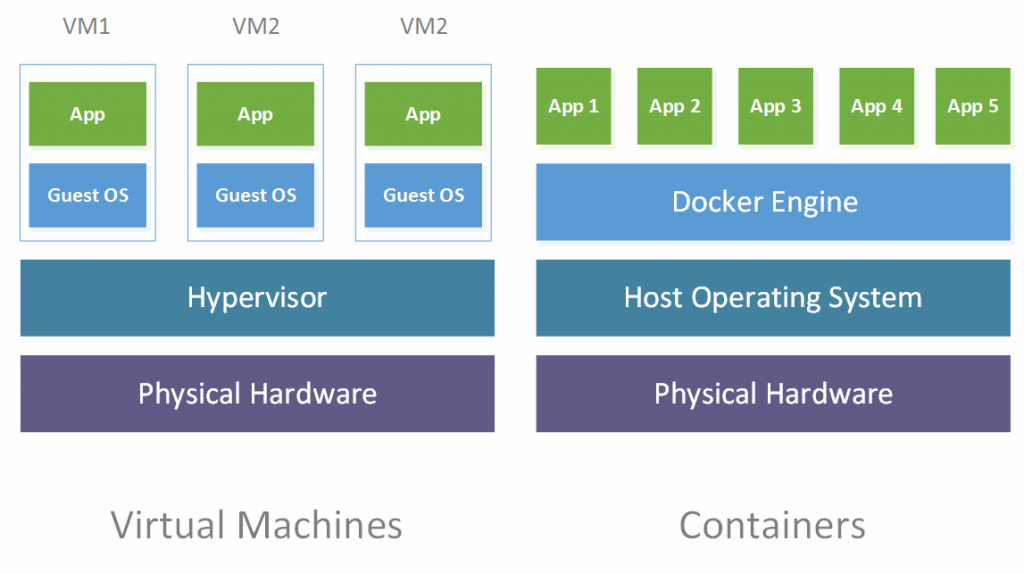
Both virtual machine and container approaches have their pros and cons, so there is no winner. Different workloads may require different infrastructure platforms to meet the IT and business requirements or objectives.
In the vSphere 6.5 release, VMware introduced vSphere Integrated Containers (VIC), a platform to bring containers into an existing vSphere environment simply and easily. With VIC, it is possible to deliver an enterprise container infrastructure that provides not only agility for developers (by using the containers) but also full control for vSphere operations teams, where containers can now be managed with the same concepts and skills as standard VMs, without requiring any changes in processes or tools.
VIC are structured into the following components:
- VIC engine: Docker remote is an API-compatible engine which is deeply integrated into vSphere (6.0, 6.5, 6.7) for instantiating container images that run as VMs, with support for distributing images to remote offices/branch offices.
- Container management portal: This portal is designed to allow apps teams to manage the container repositories, images, hosts, and running container instances. It provides Role-Based Access Control (RBAC) with support for Lightweight Directory Access Protocol/Active Directory (LDAP/AD).
- Container Registry: This securely stores container images with built-in RBAC and image replication. The container registry provides vulnerability scanning, content trust with security policies, and also supports third-party registries:
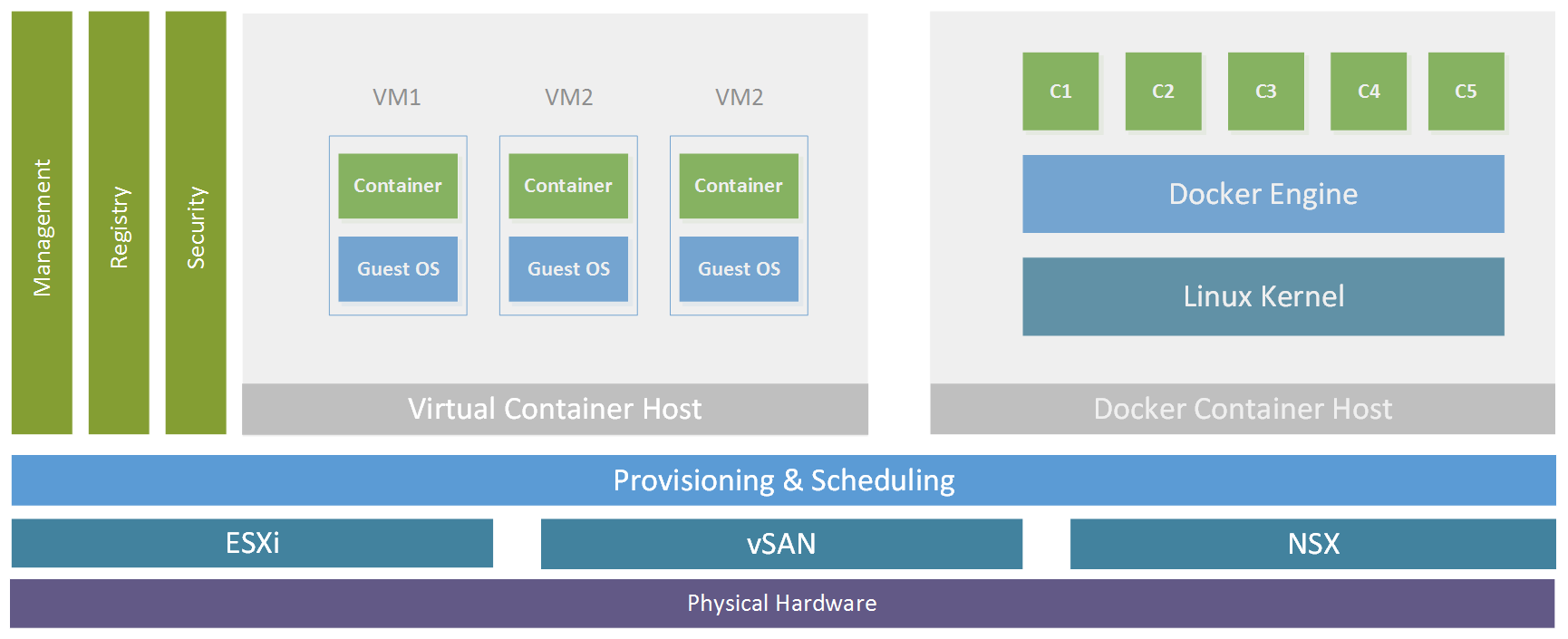
Using VIC, vSphere administrators can provide a full Docker-compatible interface to their developers, using the existing vSphere infrastructure with native capabilities and features, including VMware NSX for security and VMware vSAN for storage. The new version 1.2 (released in September 2017) adds a native Docker container host from a unified management portal.
A second product that focuses on containers is the Pivotal Container Service (PKS). In contrast to VIC, PKS focuses on multi-cloud deployments where you can natively run your containerized applications using a Kubernetes engine. Kubernetes is an orchestration platform for running Docker containers, but compared to Docker Swarm, it provides more functionality.
With PKS, you can efficiently manage one homogeneous environment, providing the same compute, network, or storage capabilities for your containerized workloads in multi-cloud environments.
PKS is structured into the following different components:
- PKS Control Plane: This is a critical component of the PKS infrastructure that is responsible for self-service access, life cycle and on-demand deployment of the Kubernetes clusters. Using APIs, the requests are sent to BOSH, which is responsible for the automation itself.
- Kubernetes: Kubernetes is an open source, portable, extensible orchestration framework for managing containerized workloads and services. Applications are run within Kubernetes clusters, providing optimized resource access and maintaining a consistent application state within clusters.
- BOSH: This is an open source tool for maintaining large-scale distributed deployments. Using BOSH, you can deploy applications to many Infrastructure as a Service solutions from supported partners to on-premises infrastructure. BOSH allows interconnection with OpenStack, VMware vSphere, AWS, Microsoft Azure, or Google Cloud Platform (GCP).
- VMware NSX-T: This is a network virtualization tool from VMware that can be deployed not only within VMware vSphere but also within other hypervisors. NSX provides sophisticated network functions from layer 2 up to layer 7. This includes micro-segmentation, load balancing, or transparent L2 bridging, for example.
- Project Harbor: This is an open source tool that acts as a centralized cloud registry for your application images as well as providing RBAC to your users using LDAP or AD integration.
Here is an overview of the components of PKS:
